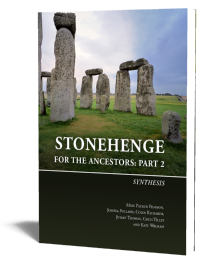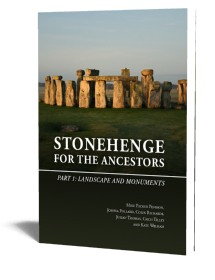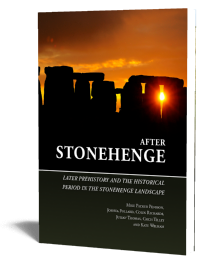Durrington Walls and Woodhenge
A place for the living
Mike Parker Pearson, Joshua Pollard, Colin Richards, Julian Thomas, Chris Tilley & Kate Welham | Forthcoming
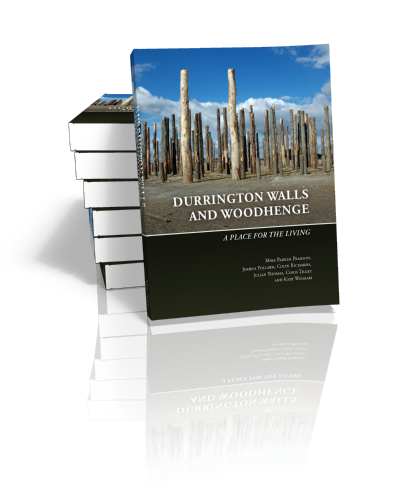
Durrington Walls and Woodhenge
A place for the living
Mike Parker Pearson, Joshua Pollard, Colin Richards, Julian Thomas, Chris Tilley & Kate Welham | Forthcoming
Hardback ISBN: 9789088907098 | Imprint: Sidestone Press | Format: 210x280mm | ca. 430 pp. | The Stonehenge Riverside Project Volume 3 | Language: English | >100 illus. (bw) | >100 illus. (fc) | Keywords: Stonehenge, archaeology, prehistory, Neolithic, Britain, megaliths, stone circles, standing stones, Bluestone, Sarsen, avenue, landscape, excavation, Durrington Walls, Woodhenge, settlement | download cover
Publication date: 2026
-
Digital & Online access
Digital/Online version not (yet) available
-
Buy via Sidestone (EU & UK)
This title is not yet available
-
Buy via our Distributors (WORLD)
This title is not yet available
-
Bookinfo
Hardback ISBN: 9789088907098 | Imprint: Sidestone Press | Format: 210x280mm | ca. 430 pp. | The Stonehenge Riverside Project Volume 3 | Language: English | >100 illus. (bw) | >100 illus. (fc) | Keywords: Stonehenge, archaeology, prehistory, Neolithic, Britain, megaliths, stone circles, standing stones, Bluestone, Sarsen, avenue, landscape, excavation, Durrington Walls, Woodhenge, settlement | download cover
Publication date: 2026

We will plant a tree for each order containing a paperback or hardback book via OneTreePlanted.org.
For many centuries, scholars and enthusiasts have been fascinated by Stonehenge, the world’s most famous stone circle. In 2003 a team of archaeologists commenced a long-term fieldwork project for the first time in decades. The Stonehenge Riverside Project (2003-2009) aimed to investigate the purpose of this unique prehistoric monument by considering it within its wider archaeological context.
This is the third of four volumes which present the results of that campaign. It reports on surveys and excavations of the great henge of Durrington Walls and its satellite, Woodhenge. Excavations uncovered remains of houses protected beneath the henge bank of Durrington Walls. Together with their middens, containing large quantities of ceramics, lithcs and faunal remains, these houses provide a remarkable insight into life at the tme of Stonehenge’s second stage of construction around 2500 BC. Two of these houses were set within small henges, the Western Enclosures, at the centre of Durrington Walls. Timber monuments investigated include the Southern Circle, the large circle around the entire circuit of Durrington Walls, Woodhenge and three other small timber monuments south of Woodhenge. Excavations into the bank of Durrington Walls henge also provide insights on how and when this huge monument was constructed.
With contributions by:
Umberto Albarella, Wayne Bennett, Andrew Chamberlain, Ben Chan, Henry Chapman, Ros Cleal, Oliver Craig, Glyn Davies, Roger Doonan, Jane Evans, Charly French, Chris Gaffney, Vince Gaffney, Paul Garwood, Barney Harris, Rob Ixer, Mandy Jay, Chris Knüsel, Neil Linford, Richard Madgwick, Pete Marshall, Claudia Minnitti, Wolfgang Neubauer, Bob Nunn, Andy Payne, Derek Pitman, Dave Robinson, Clive Ruggles, Jim Rylatt, Lisa-Marie Shillito, Ellen Simmons, Anne Teather, Alan Vince†, Sarah Viner-Daniels and Christie Willis
See the other volumes in the Stonehenge Riverside Project Series
LIST OF FIGURES
LIST OF TABLES
CONTRIBUTORS
PREFACE
ACKNOWLEDGEMENTS
1. Durrington Walls in the landscape
Henges in the Stonehenge landscape – (C. Tilley and W. Bennett)
Geophysical survey – (K. Welham with C. Gaffney, N. Linford & A. Payne)
The pre-henge buried soil in Trench 6, Durrington Walls – (C. French)
2. The village
Houses and middens – (M. Parker Pearson et al.)
Pit groups – (M. Parker Pearson et al.)
Houses within the western enclosures – (J. Thomas)
Overview of occupation around and beneath the henge earthworks – (M. Parker Pearson et al.)
3. Representations of the house
The Southern Circle – (J. Thomas)
The Southern Circle’s plan – (M. Parker Pearson, J. Pollard & C. Richards)
The Southern Circle’s sequence – (M. Parker Pearson and C. Richards)
The Southern Circle’s significance – (J. Thomas)
The Durrington Walls Avenue – (M. Parker Pearson et al.)
Woodhenge – (J. Pollard & D. Robinson)
South of Woodhenge – (J. Pollard & D. Robinson)
Timber monuments and beyond – (J. Pollard, C. Ruggles et al.)
4. Enclosure and commemoration
The line of postholes in Zone 5 – (M. Parker Pearson)
The timber circle – (M. Parker Pearson, H. Chapman, V. Gaffney, P. Garwood, W. Neubauer and J. Pollard)
The henge bank – (M. Parker Pearson)
Henge enclosures within Durrington Walls – (J. Thomas)
The south and west sides of Durrington Walls – (R. Nunn, J. Rylatt & M. Parker Pearson)
Woodhenge cove – (J. Pollard & D. Robinson)
5. Radiocarbon dating
P. Marshall
6. Pottery
Grooved Ware and Beaker pottery – (R. Cleal)
Ceramic petrology – (R. Ixer & A. Vince)
7. Lithics and sarsen-working
Stone artefacts – (B. Chan)
8. Worked bone and antler artefacts
G. Davies
9. Chalk-working
Chalk-working – (B. Harris)
Carved chalk objects – (A. Teather)
10. Faunal remains
Durrington Walls – (U. Albarella & S. Viner)
South of Woodhenge – (C. Minnitti, U. Albarella & S. Viner-Daniels)
11. Human bones
A. Chamberlain, C. Willis & C. Knüsel
12. Plant remains and wood charcoal
Carbonised plant remains – (E. Simmons)
Wood charcoal – (E. Simmons)
13. Lipid analysis of ceramics
O. Craig & L.-M. Shillito
14. Isotopic analyses
Stable isotopes – (M. Jay)
Strontium and oxygen isotopes: cattle and pig mobility and seasonality – (J. Evans, R. Madgwick, S. Viner & U.Albarella)
15. The life and times of Durrington Walls
Households, deposition and social space – (M. Parker Pearson, B. Chan et al.)
Soil micromorphology of house floors and middens – (C. French)
Spatial patterning of artefacts, burnt flint, animal bones, plant remains – (B. Chan et al.)
Geochemical and geophysical analyses – (R. Doonan and D. Pitman)
Overview – (M. Parker Pearson et al.)
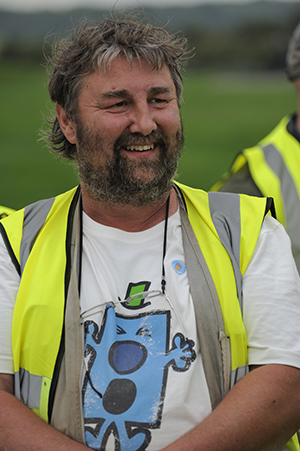
Prof. dr. Mike Parker Pearson
Mike Parker Pearson is Professor of British Later Prehistory at the Institute of Archaeology, University College London (UCL). He is a Fellow of the British Academy and has directed archaeological projects in Madagascar as well as in many parts of Britain. His books include The Archaeology of Death and Burial, Pastoralists, Warriors and Colonists and Stonehenge: investigating a Stone Age mystery.

Prof. dr. Joshua Pollard
Joshua Pollard is Professor of Archaeology at the University of Southampton. He is a leading authority on the Neolithic and Bronze Age in Britain, and is director of a major research project on the Neolithic stone circle complex at Avebury, where he has worked for many years. His books include Avebury: biography of a landscape, Landscape of the Megaliths and Avebury.

Prof. dr. Colin Richards
Colin Richards is Professor of Archaeology at the University of the Highlands and Islands in Scotland. He is a leading expert on stone circles and has excavated widely on Neolithic sites in Britain as well as on Easter Island and elsewhere in the Pacific. For many years he has been researching the Neolithic period in Orkney, where he is now based. His books include Dwelling among the Monuments, Building the Great Stone Circles of the North and The Development of Neolithic House Societies in Orkney.

Prof. dr. Julian Thomas
Julian Thomas is Professor of Archaeology at the University of Manchester. He is a leading expert on Neolithic Britain, and has directed excavations in many parts of Britain from Scotland to southern England. His books include Understanding the Neolithic, Time, Culture and Identity, and The Birth of Neolithic Britain.

Prof. dr. Chris Tilley
Chris Tilley is Professor of Anthropology at University College London (UCL). He has directed archaeological projects in Britain and has written widely on many topics including archaeological theory and phenomenology, for which he is known internationally. His books include A Phenomenology of Landscape, Metaphor and Material Culture, An Anthropology of Landscape and The Materiality of Stone.

Prof. dr. Kate Welham
Kate Welham is Professor of Archaeological Science at Bournemouth University. She has worked on projects in Britain, Kenya, Spain and Easter Island, and is a leading expert in geophysical survey as well as in archaeological materials. She is chair of the UK committee of archaeological heads of departments. She is co-author of Stonehenge: making sense of a prehistoric mystery.
Abstract:
For many centuries, scholars and enthusiasts have been fascinated by Stonehenge, the world’s most famous stone circle. In 2003 a team of archaeologists commenced a long-term fieldwork project for the first time in decades. The Stonehenge Riverside Project (2003-2009) aimed to investigate the purpose of this unique prehistoric monument by considering it within its wider archaeological context.
This is the third of four volumes which present the results of that campaign. It reports on surveys and excavations of the great henge of Durrington Walls and its satellite, Woodhenge. Excavations uncovered remains of houses protected beneath the henge bank of Durrington Walls. Together with their middens, containing large quantities of ceramics, lithcs and faunal remains, these houses provide a remarkable insight into life at the tme of Stonehenge’s second stage of construction around 2500 BC. Two of these houses were set within small henges, the Western Enclosures, at the centre of Durrington Walls. Timber monuments investigated include the Southern Circle, the large circle around the entire circuit of Durrington Walls, Woodhenge and three other small timber monuments south of Woodhenge. Excavations into the bank of Durrington Walls henge also provide insights on how and when this huge monument was constructed.
With contributions by:
Umberto Albarella, Wayne Bennett, Andrew Chamberlain, Ben Chan, Henry Chapman, Ros Cleal, Oliver Craig, Glyn Davies, Roger Doonan, Jane Evans, Charly French, Chris Gaffney, Vince Gaffney, Paul Garwood, Barney Harris, Rob Ixer, Mandy Jay, Chris Knüsel, Neil Linford, Richard Madgwick, Pete Marshall, Claudia Minnitti, Wolfgang Neubauer, Bob Nunn, Andy Payne, Derek Pitman, Dave Robinson, Clive Ruggles, Jim Rylatt, Lisa-Marie Shillito, Ellen Simmons, Anne Teather, Alan Vince†, Sarah Viner-Daniels and Christie Willis
See the other volumes in the Stonehenge Riverside Project Series
Contents
LIST OF FIGURES
LIST OF TABLES
CONTRIBUTORS
PREFACE
ACKNOWLEDGEMENTS
1. Durrington Walls in the landscape
Henges in the Stonehenge landscape – (C. Tilley and W. Bennett)
Geophysical survey – (K. Welham with C. Gaffney, N. Linford & A. Payne)
The pre-henge buried soil in Trench 6, Durrington Walls – (C. French)
2. The village
Houses and middens – (M. Parker Pearson et al.)
Pit groups – (M. Parker Pearson et al.)
Houses within the western enclosures – (J. Thomas)
Overview of occupation around and beneath the henge earthworks – (M. Parker Pearson et al.)
3. Representations of the house
The Southern Circle – (J. Thomas)
The Southern Circle’s plan – (M. Parker Pearson, J. Pollard & C. Richards)
The Southern Circle’s sequence – (M. Parker Pearson and C. Richards)
The Southern Circle’s significance – (J. Thomas)
The Durrington Walls Avenue – (M. Parker Pearson et al.)
Woodhenge – (J. Pollard & D. Robinson)
South of Woodhenge – (J. Pollard & D. Robinson)
Timber monuments and beyond – (J. Pollard, C. Ruggles et al.)
4. Enclosure and commemoration
The line of postholes in Zone 5 – (M. Parker Pearson)
The timber circle – (M. Parker Pearson, H. Chapman, V. Gaffney, P. Garwood, W. Neubauer and J. Pollard)
The henge bank – (M. Parker Pearson)
Henge enclosures within Durrington Walls – (J. Thomas)
The south and west sides of Durrington Walls – (R. Nunn, J. Rylatt & M. Parker Pearson)
Woodhenge cove – (J. Pollard & D. Robinson)
5. Radiocarbon dating
P. Marshall
6. Pottery
Grooved Ware and Beaker pottery – (R. Cleal)
Ceramic petrology – (R. Ixer & A. Vince)
7. Lithics and sarsen-working
Stone artefacts – (B. Chan)
8. Worked bone and antler artefacts
G. Davies
9. Chalk-working
Chalk-working – (B. Harris)
Carved chalk objects – (A. Teather)
10. Faunal remains
Durrington Walls – (U. Albarella & S. Viner)
South of Woodhenge – (C. Minnitti, U. Albarella & S. Viner-Daniels)
11. Human bones
A. Chamberlain, C. Willis & C. Knüsel
12. Plant remains and wood charcoal
Carbonised plant remains – (E. Simmons)
Wood charcoal – (E. Simmons)
13. Lipid analysis of ceramics
O. Craig & L.-M. Shillito
14. Isotopic analyses
Stable isotopes – (M. Jay)
Strontium and oxygen isotopes: cattle and pig mobility and seasonality – (J. Evans, R. Madgwick, S. Viner & U.Albarella)
15. The life and times of Durrington Walls
Households, deposition and social space – (M. Parker Pearson, B. Chan et al.)
Soil micromorphology of house floors and middens – (C. French)
Spatial patterning of artefacts, burnt flint, animal bones, plant remains – (B. Chan et al.)
Geochemical and geophysical analyses – (R. Doonan and D. Pitman)
Overview – (M. Parker Pearson et al.)

Prof. dr. Mike Parker Pearson
Mike Parker Pearson is Professor of British Later Prehistory at the Institute of Archaeology, University College London (UCL). He is a Fellow of the British Academy and has directed archaeological projects in Madagascar as well as in many parts of Britain. His books include The Archaeology of Death and Burial, Pastoralists, Warriors and Colonists and Stonehenge: investigating a Stone Age mystery.

Prof. dr. Joshua Pollard
Joshua Pollard is Professor of Archaeology at the University of Southampton. He is a leading authority on the Neolithic and Bronze Age in Britain, and is director of a major research project on the Neolithic stone circle complex at Avebury, where he has worked for many years. His books include Avebury: biography of a landscape, Landscape of the Megaliths and Avebury.

Prof. dr. Colin Richards
Colin Richards is Professor of Archaeology at the University of the Highlands and Islands in Scotland. He is a leading expert on stone circles and has excavated widely on Neolithic sites in Britain as well as on Easter Island and elsewhere in the Pacific. For many years he has been researching the Neolithic period in Orkney, where he is now based. His books include Dwelling among the Monuments, Building the Great Stone Circles of the North and The Development of Neolithic House Societies in Orkney.

Prof. dr. Julian Thomas
Julian Thomas is Professor of Archaeology at the University of Manchester. He is a leading expert on Neolithic Britain, and has directed excavations in many parts of Britain from Scotland to southern England. His books include Understanding the Neolithic, Time, Culture and Identity, and The Birth of Neolithic Britain.

Prof. dr. Chris Tilley
Chris Tilley is Professor of Anthropology at University College London (UCL). He has directed archaeological projects in Britain and has written widely on many topics including archaeological theory and phenomenology, for which he is known internationally. His books include A Phenomenology of Landscape, Metaphor and Material Culture, An Anthropology of Landscape and The Materiality of Stone.

Prof. dr. Kate Welham
Kate Welham is Professor of Archaeological Science at Bournemouth University. She has worked on projects in Britain, Kenya, Spain and Easter Island, and is a leading expert in geophysical survey as well as in archaeological materials. She is chair of the UK committee of archaeological heads of departments. She is co-author of Stonehenge: making sense of a prehistoric mystery.
-
Digital & Online access
Digital/Online version not (yet) available
-
Buy via Sidestone (EU & UK)
This title is not yet available
-
Buy via our Distributors (WORLD)
This title is not yet available
- Browse all books by subject
-
Search all books

We will plant a tree for each order containing a paperback or hardback book via OneTreePlanted.org.
You might also like:
© 2025 Sidestone Press KvK nr. 28114891 Privacy policy Sidestone Newsletter Terms and Conditions (Dutch)
